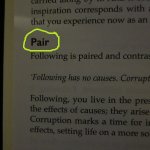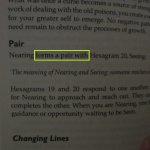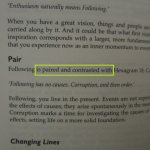Clarity,
Office 17622,
PO Box 6945,
London.
W1A 6US
United Kingdom
Phone/ Voicemail:
+44 (0)20 3287 3053 (UK)
+1 (561) 459-4758 (US).

The question is: Some authors claim that the inverse hexagram gives you an idea of what IS NOT the original hexagram...
I have a doubt because there's a lot of confusing information out there.
Before I explain it, I want to clarify some terms to be sure we are talking the same languaje.
Inverse hexagram: The hexagram is the result of turning it upside down. So, the inverse of 25 is 26.
Opposite hexagram: It is the result of changing all the lines of the hegram, so the opposite of 25 is 46.
The question is: Some authors claim that the inverse hexagram gives you an idea of what IS NOT the original hexagram, and that the opposite hexagram gives you an idea of the origin of the original hexagram.
My intuition tells me that's wrong, it's just the opposite. the inverse hexagram tells you the origin of the original hexagram and the opposite hexagram tells you what the IS NOT the original hexagram.
Could you clarify for me a little bit?
Oh, the horror!Re what Moss Elk said I don't entirely agree.
That is what I meant!There is no need to look at hexagrams of context at all in readings...
I agree!...but that doesn't mean they aren't worth looking at or being aware of sometimes.
I'm thinking what you mean by 'original hexagram' is the cast hexagram.
One thing though: 11 is NOT the inverse of 12. Hex. 11 is the inverse of 11, and 12 is the inverse of 12. They both don’t show their inverse, because how can you tell the difference between 11 and 11?
I found out that ‘opposite’ is not the right term, but it is the one most people will understand, so I guess it will stay. Contrast seems to fit better. Very often the contrast is either the situation or (more often it seems) the action. Like e.g in 5 waiting for something, and in 6 fighting for something. The situation is not entirely different, but the action is.
I get the impression, that for 'reversed' it is rather the situation which is different, but the action more or less similar. Maybe when looking further into them, I am wrong. so far it is only based of a few examples.
When I try to explain it to someone, I usually paint the image of a narrow Italian street. Washing lines from one side to the other. If you look from one window, you see the underwear first and the dresses behind it. But from the window on the other side you see the dresses and behind them the underwear. It is the same line, the same clothes, but you get an 'opposite' view on it, and you might notice some things you couldn't see from the other side.
Sorry, I seem to have made a load of mistakes.
There is a paper by Edward Hacker and Steve Moore – 'A brief note on the two-part division of the received order of the hexagrams in the Zhouyi' in which this is explained. If they are right, it is the reason for the division in two unequal parts of the Yijing. See https://www.yijing.nl/structures/mirrors/

The special pairs are what I want to explore after I get the inverse and opposite more or less clear. It is like keeping an eye on 7 newborn goats – as if your mind has to be in 7 places at once. Ever tried feeding them and keeping track of which are fed and which not yet? I had to, and we were not prepared for 7 of them. We had only 4 mama’s. All 7 babies were female, we were the talk of the goat farmers all around here.11/12 are one of four special pairs that are both inverse and opposite. It's interesting to try to see what effect that has on their relationship.
...
Complements/opposites, like 27 and 28, look like pieces of a jigsaw that slot together, or like a seal and its imprint, or a negative and its photograph.
I use the opposite and the inverse hexagrams very often. They give the original hexagram a kind of landscape.
(...)
I have been exploring the inverse and opposite hexagrams, and I am trying to put it all in an overview. https://www.yijing.nl/structures/mirrors/refl+contr/ The pages are far from being complete, for the time being it is my own space for figuring it out.
I found out that ‘opposite’ is not the right term, but it is the one most people will understand, so I guess it will stay. Contrast seems to fit better. Very often the contrast is either the situation or (more often it seems) the action. Like e.g in 5 waiting for something, and in 6 fighting for something. The situation is not entirely different, but the action is.
I get the impression, that for 'inversed' it is rather the situation which is different, but the action more or less similar. Maybe when looking further into them, I am wrong. so far it is only based of a few examples.
I made pictures of the groups of contrasts and inversions, because for me that makes it easier to encompass. Like Trojina said: it is not easy to wrap your mind around the whole thing at once.
In the future I will make a link to the pages, so they are accessible, but for now I am just trying to get it right.
When I try to explain it to someone, I usually paint the image of a narrow Italian street. Washing lines from one side to the other. If you look from one window, you see the underwear first and the dresses behind it. But from the window on the other side you see the dresses and behind them the underwear. It is the same line, the same clothes, but you get an 'opposite' view on it, and you might notice some things you couldn't see from the other side.
I use it to get a better understanding of hexagrams, not especially of a reading. But the better understanding is a help with readings of course. Any better understanding is.
 )
)Umm, what are zagua? I found this: 雜卦 and searched in Bradford's Yi, but it doesn't seem he has them. But when I looked in your book, it is the all-lines-opposite hexagram. Which is the same one I also call contrast. And some pairs are contrasts but not all of them.(Just to create vast confusion for everyone, I called the Zagua 'Contrasts' in my book, so that means you get all kinds of pair labelled as 'Contrast'.)
(Just to create vast confusion for everyone, I called the Zagua 'Contrasts' in my book, so that means you get all kinds of pair labelled as 'Contrast'.)



Yes, I was prepared to be very peeved if that was true.
That...is a distressingly good point. It clashes with my inner greedy piglet.I don't think we need clones though, one of each is enough. I mean if we can't keep up with one of Hilary how would we keep up with 3 ? I still haven't digested the Sequence course - if there were 3 of her there'd be no tonly the sequence course but other courses and we'd be left behind.
I have a chronic shortage of myselves. I'd want to do so much more, and if possible everything at once.

I just meant the 10th Wing - nothing clever. I think I should keep the paper bag close to hand.Umm, what are zagua? I found this: 雜卦 and searched in Bradford's Yi, but it doesn't seem he has them. But when I looked in your book, it is the all-lines-opposite hexagram. Which is the same one I also call contrast. And some pairs are contrasts but not all of them.
Zagua - nice!
I guess the paperbag can go into the paper-recycling bin?
Which book ? You haven't written about contrasts in 'walking your path..' maybe you mean sequence book ?
Happily, Liselle knows WYPCYF better than I do. Turns out I had the sense 9 years ago to differentiate between 'paired' and 'paired and contrasted'. Well, I'm glad someone knows what I'm doing.After being very confused since yesterday - is this part of it?
Hilary uses the term "Pair" in her book as the section heading -
View attachment 2450
- but then in the sentence below either says "forms a pair with" (for inverse, turn-180-degrees pairs) or "is paired and contrasted with" for complementary, change-every-line-to-its-opposite pairs, and also for pairs which are both of those.
View attachment 2445 View attachment 2451
Clarity,
Office 17622,
PO Box 6945,
London.
W1A 6US
United Kingdom
Phone/ Voicemail:
+44 (0)20 3287 3053 (UK)
+1 (561) 459-4758 (US).